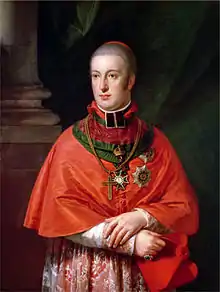Archduke Rudolf of Austria
Rudolph Johann Joseph Rainier, Archduke of Austria, Prince Royal of Hungary and Bohemia, Cardinal-Archbishop of Olomouc (8 January 1788 – 24 July 1831), was a member of the House of Habsburg-Lorraine, and an Austrian clergyman and noble. He was consecrated as Archbishop of Olomouc (Olmütz) in 1819 and became cardinal in the same year. Rudolph is known for his patronage of the arts, most notably as sponsor of Ludwig van Beethoven who dedicated several of his works to him.
Rudolph Johann Joseph Rainer Archduke of Austria | |
|---|---|
| Cardinal, Archbishop of Olomouc | |
 | |
| Metropolis | Archdiocese of Olomouc |
| See | Olomouc |
| Installed | 24 March 1819 |
| Term ended | 24 July 1831 |
| Predecessor | Maria Thaddäus von Trautmannsdorff |
| Successor | Ferdinand Maria Chotek von Chotkow |
| Other posts | Archduke of Austria |
| Orders | |
| Ordination | 19 March 1805 |
| Consecration | 26 September 1819 by Sigismund Anton von Hohenwart |
| Created cardinal | 4 June 1819 |
| Rank | Cardinal-Priest of S. Pietro in Montorio |
| Personal details | |
| Born | 8 January 1788 Florence, Tuscany |
| Died | 24 July 1831 (aged 43) Baden, Lower Austria |
| Nationality | Austrian |
| Denomination | Roman Catholic |
| Previous post | Coadjutor of Anton Theodor von Colloredo-Waldsee-Mels, Archbishop of Olomouc (1805–1811) |
| Coat of arms |  |
| Styles of Rudolph von Habsburg-Lothringen | |
|---|---|
 | |
| Reference style | His Eminence |
| Spoken style | Your Eminence |
| Informal style | Cardinal |
| See | Olomouc |
Biography
Born in the Pitti Palace in Florence, Tuscany, he was the youngest son of Emperor Leopold II and Maria Louisa of Spain. In 1803 or 1804, Rudolph began taking lessons in piano and composition from Ludwig van Beethoven. The two became friends, and Rudolph became a supporter and patron of Beethoven; their meetings continued until 1824. Beethoven dedicated 14 compositions to Rudolph, including the Archduke Trio, the Hammerklavier Sonata, the Emperor Concerto and the Missa Solemnis. Piano Sonata No. 26 - Les Adieux ("The Farewells") was gifted to Rudolf just before his flight from Vienna with the Royal family on the occasion of the 1809 invasion by Napoleon. The movements are "Lebewohl", "Abwesenheit", and "Wiedersehen" ('farewell', 'absence', and 'reunion'). Rudolph dedicated one of his own compositions to Beethoven. The letters Beethoven wrote to Rudolph are today kept at the Gesellschaft der Musikfreunde in Vienna.
Schubert and Ferdinand Ries also dedicated works to Rudolf.[1]
On 24 March 1819 aged 31 Rudolph was appointed, Archbishop of Olomouc, in the present day Czech Republic but then part of the Austrian Empire. He was made Cardinal-Priest of the titular church of S. Pietro in Montorio by Pope Pius VII on 4 June 1819. He was ordained a priest on 29 August 1819, and consecrated a bishop on 26 September.
In 1823–24, he was one of the 50 composers who composed a variation on a waltz by Anton Diabelli for Vaterländischer Künstlerverein. In Rudolph's case, the music was published anonymously, as by "S.R.D" (standing for Serenissimus Rudolfus Dux).
He died on 24 July 1831 of a cerebral hemorrhage in Baden bei Wien at the age of 43 and was interred in the Imperial Crypt in Vienna; his heart was buried in the crypt in Saint Wenceslas Cathedral in Olomouc.
Ancestors
Sources
- See IMSLP: Schubert's Piano Sonata No.16 (D.845) and Ries' piano quartet Op.129 in E minor.
- Genealogie ascendante jusqu'au quatrieme degre inclusivement de tous les Rois et Princes de maisons souveraines de l'Europe actuellement vivans [Genealogy up to the fourth degree inclusive of all the Kings and Princes of sovereign houses of Europe currently living] (in French). Bourdeaux: Frederic Guillaume Birnstiel. 1768. p. 109.
External links
 Media related to Rudolph von Österreich at Wikimedia Commons
Media related to Rudolph von Österreich at Wikimedia Commons
| Preceded by Maria Tadeáš von Trauttmansdorf-Wiensberg |
Archbishop of Olomouc 1819-1831 |
Succeeded by Ferdynand Maria von Chotek |
